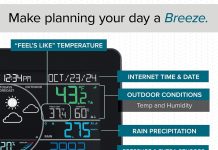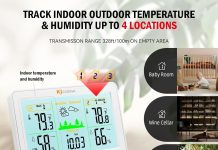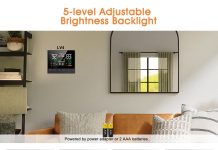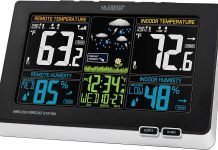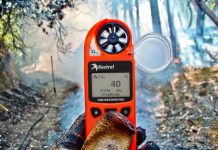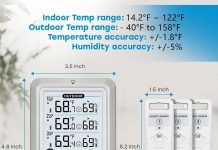In our quest to better understand the weather patterns in our surroundings, we often turn to home weather stations for accurate and up-to-date information. But have you ever wondered what kind of sensors these stations use to provide us with this valuable data? From temperature and humidity sensors to wind and rain gauges, these home weather stations are equipped with a wide range of sensors that work harmoniously to bring us comprehensive weather information right at our fingertips. Join us as we unravel the fascinating world of sensors used in home weather stations and discover the science behind these reliable weather forecasting devices.
Review contents
Temperature Sensors
Thermistor
Thermistors are commonly used temperature sensors in home weather stations. These sensors rely on the characteristics of a special type of resistor, called a thermistor, which changes its resistance with fluctuations in temperature. Thermistors are highly sensitive to temperature changes and can provide accurate readings over a wide range of temperatures. They are cost-effective, compact, and commonly used in various weather monitoring applications.
Resistance Temperature Detector (RTD)
RTDs are another type of temperature sensor used in home weather stations. These sensors rely on the principle that the electrical resistance of certain metals increases with temperature. RTDs are known for their high accuracy and stability, making them ideal for precise temperature measurements. They are commonly used in professional weather monitoring systems where accuracy is crucial.
Thermocouple
Thermocouples are widely used temperature sensors that generate a small voltage when there is a temperature difference between two junctions. They are composed of two different metals joined together, creating a thermoelectric effect. Thermocouples are known for their durability and ability to measure extremely high temperatures. They are commonly used in industrial and research applications where high-temperature measurements are required.
Humidity Sensors
Capacitive
Capacitive humidity sensors are commonly used in home weather stations to measure the moisture content in the air. These sensors utilize the principle of capacitance, where the humidity level affects the dielectric properties of a material. Capacitive sensors provide accurate and reliable humidity measurements and are commonly used in various indoor and outdoor applications.
Resistive
Resistive humidity sensors, also known as hygrometers, measure humidity based on the change in resistance of a hygroscopic material. These sensors are cost-effective, compact, and widely used in home weather stations. However, they tend to be less accurate compared to capacitive sensors and require regular calibration.
Thermal Conductivity
Thermal conductivity humidity sensors measure humidity by detecting the change in thermal conductivity of a material when exposed to varying humidity levels. These sensors rely on the principle that air with higher humidity conducts heat more effectively than dry air. Thermal conductivity sensors offer good accuracy and are commonly used in weather monitoring systems where precise humidity measurements are required.
Barometric Pressure Sensors
Piezoresistive
Piezoresistive pressure sensors measure barometric pressure by detecting the small changes in electrical resistance that occur when pressure is applied. These sensors consist of a flexible diaphragm that deforms under pressure, resulting in a change in resistance. Piezoresistive sensors are known for their high accuracy and sensitivity, making them ideal for barometric pressure measurements in home weather stations.
Capacitive
Capacitive pressure sensors use the change in capacitance when pressure is applied to measure barometric pressure. These sensors rely on the principle that the distance between two conductive plates changes in response to pressure changes. Capacitive sensors offer high accuracy and stability, making them suitable for various meteorological applications.
Optical
Optical pressure sensors, also known as optoelectronic sensors, utilize changes in optical properties to measure barometric pressure. These sensors can detect pressure-induced changes in refractive index or optical interference patterns, providing accurate pressure measurements. However, optical pressure sensors are less common in home weather stations compared to other types of pressure sensors.
Strain Gauge
Strain gauge pressure sensors measure pressure by detecting the mechanical strain in a resisting element. These sensors consist of a flexible diaphragm that deforms under pressure, causing a change in resistance. Strain gauge sensors are widely used in various industrial and environmental applications, including home weather stations, due to their accuracy and reliability.
Wind Speed and Direction Sensors
Cup Anemometer
Cup anemometers are commonly used to measure wind speed in home weather stations. They consist of three or four cups that rotate in response to wind, and the number of rotations is proportional to the wind speed. Cup anemometers are simple, reliable, and cost-effective, making them popular in weather monitoring systems.
Ultrasonic Anemometer
Ultrasonic anemometers are advanced sensors that use ultrasonic sound waves to measure wind speed and direction. These sensors transmit and receive sound waves at different angles, allowing them to calculate wind speed and direction based on the time it takes for the sound waves to travel. Ultrasonic anemometers offer high accuracy and are commonly used in professional weather stations.
Vane Anemometer
Vane anemometers, also known as wind vanes, are used to measure wind direction. These sensors consist of a vane that aligns itself with the wind direction. By measuring the orientation of the vane, wind direction can be determined. Vane anemometers are popular in home weather stations due to their simplicity and affordability.
Precipitation Sensors
Tipping Bucket
Tipping bucket rain gauges are commonly used to measure rainfall in home weather stations. These sensors consist of a bucket that tilts when filled with a certain amount of rain, thus recording the measurement. Tipping bucket rain gauges are accurate, reliable, and can measure both the intensity and duration of rainfall.
Optical Rain Gauge
Optical rain gauges, also known as laser rain gauges, use light beams to detect rain droplets and measure rainfall intensity. These sensors rely on the principle that rain droplets scatter light, and the intensity of scattered light is proportional to the rainfall rate. Optical rain gauges offer high accuracy and are commonly used in professional weather monitoring systems.
Paul Wet/Dry Precipitation Gauge
Paul wet/dry precipitation gauges are specialized sensors used to measure both liquid and solid precipitation. These gauges consist of a wet chamber for liquid precipitation and a dry chamber for solid precipitation. By continuously monitoring the weight of both chambers, the amount of precipitation can be accurately determined.
Acoustic Disdrometer
Acoustic disdrometers are advanced sensors that use sound waves to measure the size and velocity of falling raindrops. These sensors can provide detailed information about rainfall characteristics, such as drop size distribution and rainfall intensity. Acoustic disdrometers are commonly used in research and professional weather monitoring systems.
Solar Radiation Sensors
Pyranometer
Pyranometers are widely used solar radiation sensors in home weather stations. These sensors measure the total amount of solar radiation, including both direct and diffuse radiation. Pyranometers are essential for monitoring solar energy, and they provide accurate measurements of solar radiation levels.
Pyroelectric Sensor
Pyroelectric sensors measure solar radiation by detecting the change in electric polarization of certain materials when exposed to radiation. These sensors are sensitive to a wide range of wavelengths and offer high accuracy. Pyroelectric sensors are commonly used in scientific and research applications.
Photodiode
Photodiodes are commonly used to measure solar radiation levels in home weather stations. These sensors generate a small electric current when exposed to light, and the current is proportional to the intensity of the incident radiation. Photodiodes are cost-effective, compact, and widely used for solar radiation measurements.
Silicon Pyranometer
Silicon pyranometers, also known as silicon solar cells, are solar radiation sensors that generate an electric current when exposed to light. These sensors are highly sensitive and can accurately measure solar radiation levels. Silicon pyranometers are commonly used in home weather stations due to their affordability and reliability.
UV Index Sensors
Ultraviolet (UV) Photodiodes
UV photodiodes are commonly used to measure UV radiation levels in home weather stations. These sensors generate an electric current when exposed to UV radiation, and the current is proportional to the intensity of UV radiation. UV photodiodes are essential for monitoring UV index and providing information about potential skin damage caused by UV radiation.
Ultraviolet (UV) Light Sensors
UV light sensors are widely used to measure UV radiation levels in home weather stations. These sensors utilize photodiodes or other light-sensitive materials to detect UV radiation. UV light sensors provide accurate measurements of UV radiation and are commonly used for determining UV index values.
Air Quality Sensors
Carbon Dioxide (CO2)
Carbon dioxide sensors are used to measure the concentration of CO2 in the air. These sensors are crucial for monitoring indoor air quality and can provide information about ventilation efficiency. Carbon dioxide sensors are commonly used in home weather stations to ensure optimal air quality.
Volatile Organic Compounds (VOCs) Sensors
VOCs sensors are used to measure the concentration of volatile organic compounds in the air. These sensors detect and quantify various chemical compounds that can affect indoor air quality. VOCs sensors are essential for monitoring potential pollutants and ensuring a healthy living environment.
Particulate Matter (PM)
Particulate matter sensors, also known as PM sensors, measure the concentration of fine particles in the air. These sensors can detect and quantify pollutants such as dust, smoke, and other airborne particles. PM sensors are important for monitoring air pollution levels and can provide valuable information about the overall air quality.
Nitrogen Dioxide (NO2)
Nitrogen dioxide sensors are used to measure the concentration of NO2, a common air pollutant emitted by vehicles and industrial activities. These sensors play a crucial role in monitoring air pollution levels and can provide insights into the impact of NO2 on human health. Nitrogen dioxide sensors are commonly used in home weather stations to ensure a healthy environment.
Ozone (O3)
Ozone sensors measure the concentration of ozone, a highly reactive gas that can be both beneficial and harmful depending on its concentration. These sensors are important for monitoring ozone levels and providing information about potential risks associated with high ozone concentrations. Ozone sensors are commonly used in home weather stations to ensure the safety of the surrounding environment.
Soil Moisture Sensors
Tensiometers
Tensiometers are soil moisture sensors that measure the tension or suction force exerted by water in the soil. These sensors provide information about soil moisture levels and can help in irrigation management. Tensiometers are commonly used in agricultural applications and home gardening to ensure optimal soil moisture levels.
Capacitive Sensors
Capacitive soil moisture sensors measure soil moisture by detecting changes in the dielectric properties of the soil. These sensors utilize the principle that soil moisture affects the capacitance of a material. Capacitive sensors are popular in home weather stations and gardening applications due to their accuracy and ease of use.
Frequency Domain Reflectometry (FDR)
FDR soil moisture sensors measure soil moisture by sending electromagnetic waves into the soil and analyzing the reflected signals. These sensors can accurately determine the dielectric permittivity of the soil, which is directly related to soil moisture levels. FDR sensors are widely used in professional agriculture and research applications.
Dielectric Moisture Sensors
Dielectric moisture sensors measure soil moisture by determining the dielectric constant of the soil. These sensors measure the ability of the soil to store an electrical charge, which is directly related to soil moisture content. Dielectric moisture sensors offer high accuracy and are commonly used in various soil moisture monitoring applications, including home weather stations.
Lightning Detection Sensors
Electric Field Mill
Electric field mills are lightning detection sensors that measure the atmospheric electric field. These sensors consist of a rotating rod and electrodes, which measure the electric potential difference caused by the presence of electric charges in the atmosphere. Electric field mills are commonly used in lightning detection systems to provide early warning and protection against lightning strikes.
Radio Frequency Detection
Radio frequency lightning detection sensors detect the electromagnetic radiation emitted by lightning discharges. These sensors can accurately locate and measure the intensity of lightning strikes. Radio frequency detection sensors are commonly used in lightning detection systems for real-time monitoring and analysis of lightning activity.
Magnetic Direction Finder
Magnetic direction finders are specialized sensors used to determine the direction of lightning strikes based on changes in the Earth’s magnetic field. These sensors can provide valuable information about the location and intensity of lightning activity. Magnetic direction finders are commonly used in lightning detection networks to improve the accuracy and reliability of lightning warnings.


